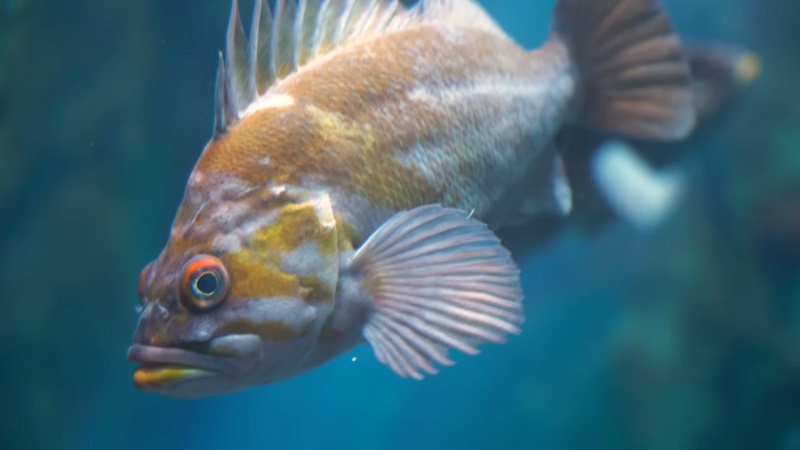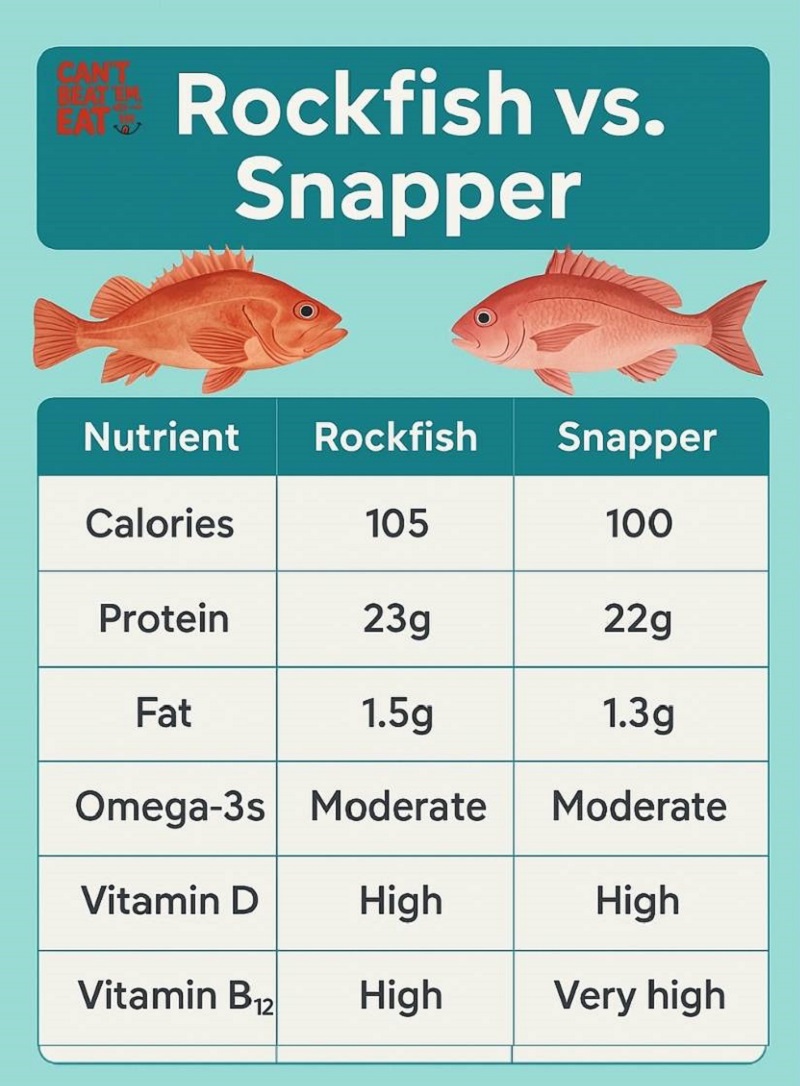Many people see rockfish and snapper labeled the same in markets or on menus. That leads to confusion. Both come in fillet form, both taste mild, and both appear with reddish skin. That surface-level similarity hides major differences.
One grows in cold Pacific waters. The other thrives in warm Atlantic and Gulf habitats. One belongs to a complex group with over 100 species. The other belongs to a smaller family with a single popular type.
Their lifespans, fishing practices, and flavor profiles all separate them. Each fish offers value, but clarity matters. You deserve to know exactly what goes on your plate. That includes real facts about origin, biology, texture, flavor, and sustainability concerns.
Scientific Names and Classifications
Labels often blur the truth, but scientific grouping makes the difference clear. Rockfish and snapper do not share the same family, genus, or species traits. Their biology sets them apart completely.
| Detail | Rockfish (Sebastes) | Snapper (Lutjanus) |
| Family | Scorpaenidae | Lutjanidae |
| Number of Species | Over 100 | Under 20 in Common Use |
| Popular Type | Pacific Rockfish | Red Snapper |
| Lifespan | Up to 200 Years | Around 50 Years |
| Body Traits | Spiny, Bony Fins | Sleek Body, Smooth Structure |
Rockfish include a wide range of species, many with long lifespans and venomous spines. Snapper grow faster, live shorter lives, and show a more uniform body shape. Scientific classification matters because it shapes how each fish behaves, grows, and ends up on your plate.
Habitat and Natural Range
Rockfish and snapper live in different oceans, temperatures, and underwater structures. Habitat affects how they grow, how they are caught, and how they taste. Location also plays a role in price, fishing rules, and environmental impact.

Pacific Depths for Rockfish
Rockfish live mostly in the Pacific Ocean. They appear along the coasts of California, Oregon, Washington, British Columbia, and Alaska. Some species stay near rocky shores. Others hide deep, sometimes at depths over 900 feet.
Most live near reefs, boulders, or kelp forests. They do not migrate far and often stay in one area for years. Cooler waters and long lifespans give rockfish firm texture and slower growth. Because they live in stable zones, overfishing in one spot can wipe out an entire age group.
Warm Waters for Snapper
Snapper prefer tropical and subtropical areas. They are common in the Gulf of Mexico, the Caribbean Sea, and along the southeastern coast of the United States. Most live near coral reefs, wrecks, or ledges.
They like warm, shallow waters with strong food supply. Snapper move more often than rockfish and grow faster. They reproduce more frequently, which supports larger fishing yields. Their habitat produces a different kind of muscle structure and flavor.
Fishing Zones Shape Quality
Cold-water fish like rockfish take longer to mature. That makes them rich in flavor but vulnerable to pressure. Warm-water fish like snapper reach harvest size sooner, which supports a steady supply. Ocean temperature, water depth, and seafloor features all shape the texture and availability of the fish on your plate.
Physical Traits and Appearance
Visual differences between rockfish and snapper become clear once you know where to look. Color alone does not tell the full story. Body shape, fin structure, eyes, and even skin texture help you tell them apart.

Shape and Size Comparison
Rockfish tend to have shorter, stockier bodies. Their heads appear more angular. Fins are thick, often spiny, and some species have venomous tips. Their bodies may look armored with tough scales and sharp ridges.
Snapper look longer and more tapered. They have a clean, smooth silhouette and larger eyes. Their snouts are more pointed, and their fins are softer. Nothing about snapper appears jagged or rough.
Skin and Color Details
Rockfish display mixed patterns. Colors range from deep red to brown, orange, yellow, and black. Some show blotches or vertical stripes. Eye bulging is common, especially in deep-sea species. Snapper, especially red snapper, appear more uniform.
Skin stays bright red or pink with a white underside. No visible patterns, no dramatic contrasts. Their eyes often glow red under light.
Side-by-Side Comparison
| Feature | Rockfish | Snapper |
| Body Shape | Short and thick | Long and lean |
| Snout | Short, blunt | Long, pointed |
| Fin Type | Thick, often spiny | Thin, soft |
| Common Color | Red, brown, orange, speckled | Red or pink with white belly |
| Eye Size | Large, often bulging | Large but flat |
Flavor and Texture Differences
| Flake structure | Fine and delicate | Thick and strong |
| Mouthfeel | Soft and moist | Firm and dense |
| Flavor strength | Light, sweet, subtle | Full, sweet, earthy |
Taste separates rockfish and snapper more than looks ever could. Both offer mild flavors, but one leans clean and delicate, while the other feels firmer and carries deeper muscle tones.
What Rockfish Tastes Like
Rockfish delivers a soft, slightly sweet flavor. The flesh feels lean and moist, with a flake that breaks apart gently. It does not leave a strong aftertaste. Many describe it as clean and easy to pair with herbs, butter, or lemon. Because it cooks quickly, rockfish fits best in sautéed or baked dishes.
What Snapper Tastes Like
Snapper gives a stronger taste without being overpowering. The sweetness feels deeper and richer. The flesh is firm and holds together well on a grill or in a pan. It does not fall apart easily. It absorbs marinades and seasonings well and stands up to chili, lime, and garlic.
Cooking Methods and Uses
Cooking style plays a major role in how well each fish performs. Some fish fall apart under high heat. Others stay firm and hold shape through heavy seasoning. Knowing how each behaves in the kitchen saves money, time, and stress.
Best Ways to Cook Rockfish

Rockfish works well in dishes that use gentle heat. Baking, broiling, or pan-searing brings out its natural sweetness. Steaming also helps preserve the fine texture. Heavy spices may drown out the flavor. Sauces like lemon butter or light garlic blends work best.
Popular uses:
- Baked rockfish with herbs
- Fish tacos with cabbage and crema
- Sautéed fillet with lemon and parsley
Best Ways to Cook Snapper

Snapper holds up to high-heat methods. It can be grilled, fried, blackened, or even roasted whole. The flesh locks in juices and carries seasonings through each bite. It pairs well with Caribbean, Latin, and Southern flavors.
Popular uses:
- Whole grilled snapper with lime
- Blackened snapper with Cajun spices
- Fried snapper with rice and beans
Rockfish fits best in light, clean plates. Snapper supports bold recipes with strong seasoning.
Nutritional Content
Both rockfish and snapper offer solid nutrition. Low in fat. High in protein. Strong sources of vitamins and minerals that support heart health, brain function, and muscle repair.

Rockfish carries slightly more vitamin D. Snapper delivers more B12. Both contain enough selenium to support immunity and metabolism. No heavy fats. No hidden sugars. Both fit into healthy diets easily.
Labeling Issues and Buyer Confusion
Markets often blur the lines between rockfish and snapper. Mislabeling happens across grocery chains, fishmongers, and even restaurants. That leads to price confusion, substitution, and unfair sourcing.
Why Mislabeling Happens
Rockfish sometimes gets labeled as snapper to raise the price. Snapper has higher demand and costs more by the pound. Because both fish look reddish and white when filleted, most buyers cannot tell the difference.
Risks for Buyers
- Paying more for a cheaper fish
- Getting the wrong texture for your recipe
- Buying from overfished stocks without knowing
To avoid mistakes, always check:
- Country of origin
- Latin name (Sebastes vs. Lutjanus)
- Whole fish presentation, if possible
Final Verdict
Rockfish and snapper do not belong in the same category. They come from different waters, different families, and follow different biological rules. Every trait—from body shape to flavor depth—tells a separate story.
Rockfish grows in cold Pacific zones, lives longer, and carries a delicate texture with mild taste. Snapper comes from warm tropical waters, matures faster, and delivers a firmer, richer bite. Those facts change how you cook, what you pay, and what you expect on the plate.

